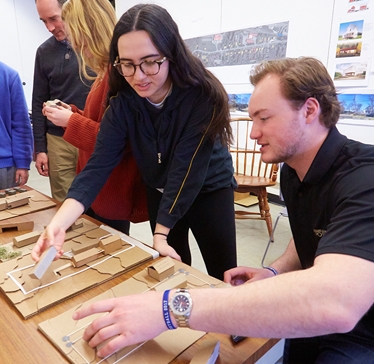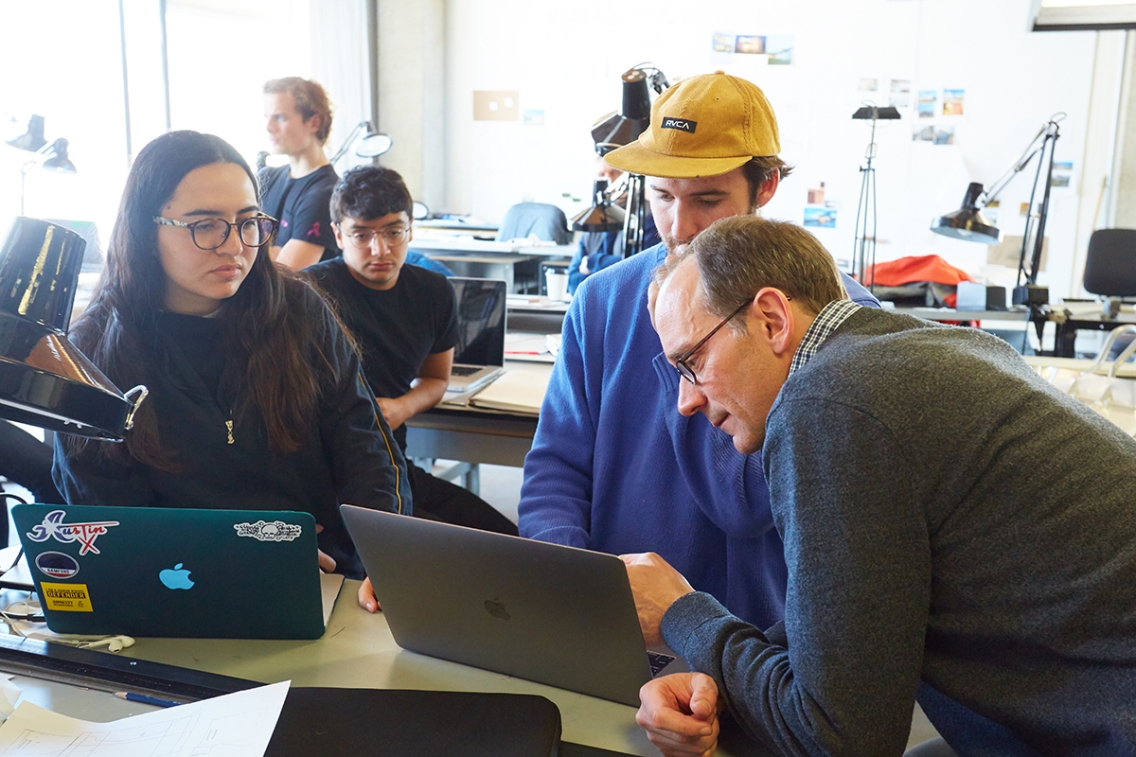Students Design Affordable Housing for Local Residents

MIDDLEBURY, VT. – Architecture students from Middlebury College are partnering with Habitat for Humanity of Addison County to design a residence that will be constructed for two families in the town of Middlebury in 2019.
This spring, the 14 students in Assistant Professor John McLeod’s Intermediate Architectural Design course are exploring possibilities for the site located at 51 Seymour Street. They have researched the town’s zoning regulations, examined the deed, analyzed the lot, determined the local and state permitting requirements, spoken with neighbors, and learned about Habitat for Humanity’s specific needs.
The students have developed three “viable approaches” to the duplex project, including a single subdivided building, two buildings loosely connected, or two completely separate structures. They have built 3-D models and created scale drawings to better understand the possibilities, and later this week the students—along with representatives from Habitat for Humanity and their professor—will meet in open session with members of the town’s Design Advisory Committee.
“Our goal,” said McLeod, a registered architect and principal in the firm McLeod Kredell Architects, “is to have a single design scheme by the end of the semester that hopefully will have the support of the town, Habitat for Humanity, and everyone else involved. This is an experiment, a pilot project, and all of us are designing the process as we go along.”
The partnership with Habitat for Humanity calls for Middlebury College to design the home in 2018 and for Habitat for Humanity to build it in 2019.
Mickey Heinecken of Cornwall, the president of the local Habitat for Humanity affiliate, pointed out that Middlebury College students have been active volunteers with Habitat for Humanity for the past 15 years and that the new partnership represents “a brave new endeavor” in the relationship.

Assistant Professor John McLeod discusses a design issue with students in his architectural studies course. The class is designing a home for the local chapter of Habitat for Humanity.
“Habitat benefits from the creative energy brought by the students, and they in turn experience firsthand the challenges of creating affordable housing. The collaboration also brings to the forefront the real need for affordable housing in Addison County, not just in the eyes of the students but for everyone fortunate enough to live here,” he said.
Architecture student Paige Ballard ’20 would agree. She said, “We are dedicating ourselves to creating two homes that will have real and lasting impact on the neighborhood, the town, and—most importantly—the families that will reside within them. It’s exciting to work on such a wholesome, large-scale, and professional-level project.”
Reed Martin ’19 said the primary goal of the class is to “interact with Habitat for Humanity representatives and community members to design a project that fits into the constructed and natural context of Middlebury. This opportunity to see what a design project looks like from conception to construction has caused me to rethink the intricacies of the architectural process in how it relates to community, aesthetic, and sustainability.”
A sophomore Feb, John Henry Hanson ’20.5, pointed out that in most undergraduate courses in architecture, “the design-build process is theoretical, because there is no client and the project will not be built.” But this course (HARC 330) is different because “the student is faced with the responsibilities of a practicing architect—creating a conversation with the site, the people of the town, and fellow designers. To see these challenges realized as a new home in the town of Middlebury will be one of the most influential experiences in my study of architecture.”
After conclusion of this semester’s initial design phase, McLeod plans to engage students in a course next fall that will advance design development, prepare working drawings, and perform cost estimates. During winter term, students will finalize the drawings and other details to get ready for construction—by Habitat for Humanity volunteers—in the spring of 2019.
– Reporting by Robert Keren; photography by Todd Balfour
For More Information
Middlebury’s program in Architectural Studies
McLeod Kredell Architects

